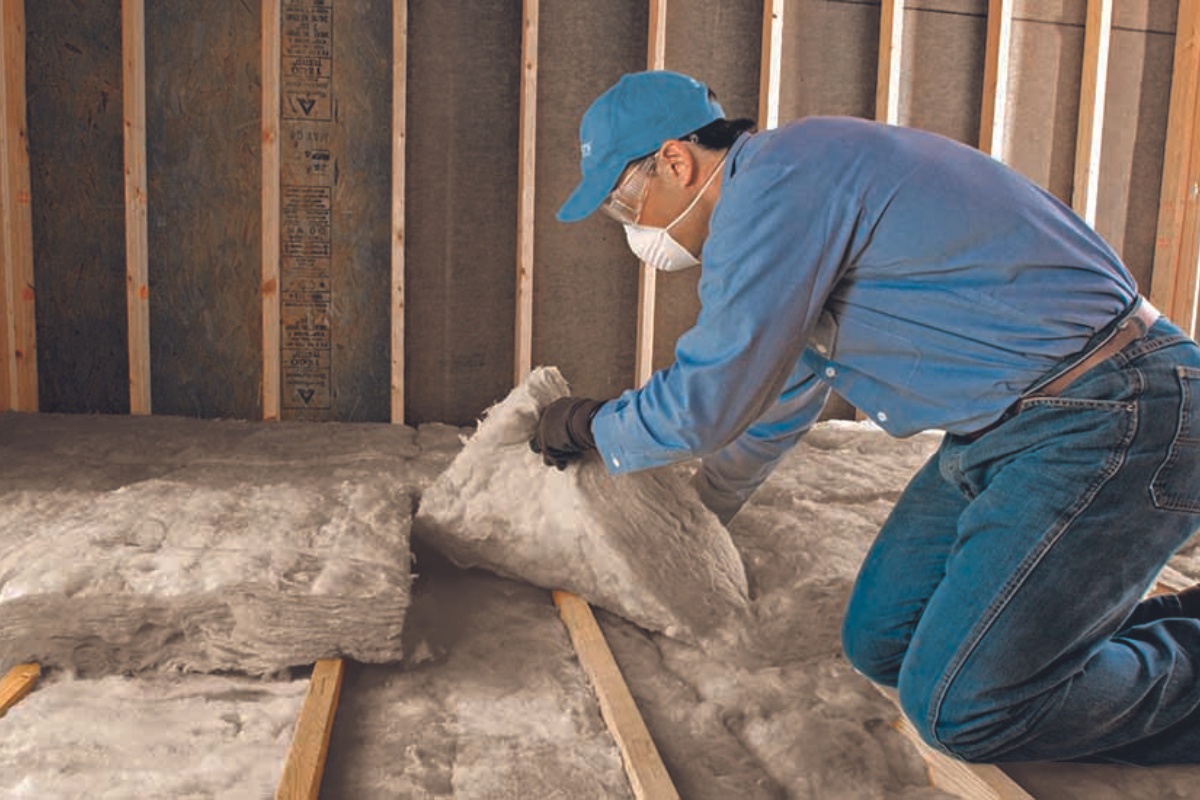Home>Home Maintenance>How To Start An Air Conditioning Business


Home Maintenance
How To Start An Air Conditioning Business
Modified: March 6, 2024
Learn how to start your own air conditioning business with our comprehensive guide. Discover key strategies and tips for success in the home maintenance industry.
(Many of the links in this article redirect to a specific reviewed product. Your purchase of these products through affiliate links helps to generate commission for Storables.com, at no extra cost. Learn more)
Introduction
Starting an air conditioning business can be a lucrative venture for those with a passion for home maintenance and a desire to provide a valuable service to their community. With the demand for air conditioning systems on the rise, there is ample opportunity to establish a successful business in this field. However, like any business endeavor, it requires careful planning, research, and a solid understanding of the industry.
In this article, we will guide you through the essential steps involved in starting an air conditioning business. From researching and planning to acquiring the necessary licenses, setting up your business, creating a marketing strategy, acquiring equipment, hiring and training employees, and managing finances, we will cover everything you need to know to get your business up and running.
Before diving into the specifics, it’s important to understand the importance of having a strong foundation for your business. This includes developing a comprehensive business plan that outlines your goals, target market, competition, pricing strategy, and marketing tactics. A well-thought-out business plan will not only serve as a roadmap for your business but will also be essential when seeking financing or attracting potential investors.
Additionally, conducting thorough market research is crucial to identify your target audience, evaluate the competition, and determine the demand for air conditioning services in your area. Understanding the needs and preferences of your potential customers will enable you to tailor your services to meet their specific requirements and stand out from the competition.
Once you have completed your research and planning, it’s time to move on to the next crucial step: obtaining the necessary licenses and permits. Operating an air conditioning business without the required licenses and permits can result in legal consequences, fines, and damage to your reputation. Therefore, it’s essential to understand the licensing requirements in your jurisdiction and ensure compliance with all regulations.
Now that we have covered the importance of research, planning, and obtaining the necessary licenses, we will delve into the steps required to set up your air conditioning business. This includes choosing a legal structure, registering your business, obtaining insurance coverage, and setting up a dedicated workspace. Creating a professional and organized foundation for your business will not only instill confidence in your customers but will also enable you to streamline your operations and provide efficient services.
In the next sections of this article, we will discuss developing a comprehensive marketing strategy, acquiring the necessary equipment and supplies, hiring and training employees, providing excellent customer service, managing finances and bookkeeping, and finally, expanding and growing your business.
With dedication, hard work, and a commitment to delivering exceptional service, you can build a successful air conditioning business that thrives in the competitive home maintenance industry. So, let’s get started and embark on this exciting entrepreneurial journey!
Key Takeaways:
- Starting an air conditioning business requires thorough research, proper licensing, and a strong foundation. Providing excellent customer service and managing finances are crucial for long-term success.
- Expanding an air conditioning business involves assessing market demand, enhancing service offerings, and strengthening customer relationships. Strategic planning and financial monitoring are essential for sustainable growth.
Read more: How To Start A Furniture Business
Research and Planning
Before diving into the world of starting an air conditioning business, it is crucial to conduct comprehensive research and planning. This will help you gain a clear understanding of the market, identify potential challenges and opportunities, and develop a solid foundation for your business.
Start by researching the demand for air conditioning services in your area. Take into account factors such as climate, population density, and existing competition. Understanding the market needs will allow you to tailor your services to meet the demands of potential customers. Additionally, consider the seasonality of the business – air conditioning services tend to be busiest during the warmer months, so plan for fluctuations in demand and adjust your resources accordingly.
Next, research your competition. Identify the key players in the industry and analyze their offerings, pricing, target market, and marketing strategies. This will help you identify gaps in the market and develop a unique selling proposition (USP) that sets your business apart. Additionally, take note of any areas where your competitors may be falling short in terms of customer service or quality, as this can present an opportunity to differentiate your business.
Once you have a good understanding of the market and competition, it’s time to define your target audience. Consider factors such as demographics, income level, and specific needs for air conditioning services. This will help you tailor your marketing efforts and develop a targeted approach to reach your ideal customers.
Another aspect of research and planning is determining your pricing strategy. Take into account factors such as the cost of equipment, supplies, labor, and overhead expenses. It’s important to strike a balance between offering competitive prices and ensuring profitability for your business. Consider offering different pricing packages or service options to cater to a wide range of customers’ budgets and needs.
Finally, develop a comprehensive business plan that outlines your goals, strategies, and financial projections. Your business plan will serve as a roadmap for your business and will be essential when seeking financing or attracting potential investors. Include a detailed marketing plan, operational plan, and financial plan in your business plan.
In summary, research and planning are crucial steps in starting an air conditioning business. Conduct thorough market research, analyze the competition, define your target audience, determine your pricing strategy, and develop a comprehensive business plan. By investing time and effort in this initial phase, you will lay a solid foundation for your business and increase your chances of long-term success in the industry.
Obtaining Necessary Licenses and Permits
One crucial step in starting an air conditioning business is obtaining the necessary licenses and permits. Operating without the proper legal documentation can result in penalties, fines, and even the shutdown of your business. It’s important to familiarize yourself with the licensing requirements in your jurisdiction and ensure compliance with all regulations.
Start by researching the specific licenses and permits required to operate an air conditioning business in your area. The requirements may vary depending on your location, so it’s important to reach out to your local government or licensing authority to get accurate and up-to-date information.
Here are the most common licenses and permits you may need to obtain:
- Business License: This is a general license required to operate any business legally. It ensures that your business is registered and compliant with local regulations.
- Contractor’s License: Depending on your jurisdiction, you may need a contractor’s license specifically for air conditioning services. This license typically requires passing an exam and demonstrating your knowledge and proficiency in the field.
- Trade License: Some areas may require a separate trade license specifically for air conditioning work. This license ensures that you have the necessary skills and expertise to provide air conditioning services.
- Environmental Permits: Depending on the type of refrigerants used in your air conditioning systems, you may need to obtain environmental permits to handle and dispose of these substances properly. This is to ensure compliance with environmental regulations and prevent any harm to the environment.
- Insurance: While not a license or permit, it’s important to obtain proper insurance coverage for your business. This includes general liability insurance to protect against any accidents or damages that may occur during your work.
Once you have identified the licenses and permits you need, gather all the required documentation and submit your applications to the appropriate licensing authorities. Make sure to provide accurate information and follow any additional instructions or requirements specified by the authorities.
Keep in mind that the process of obtaining licenses and permits may take some time, so it’s crucial to start this process early on in your business planning. This will ensure that you have all the necessary legal requirements in place before you start offering your services to customers.
Remember, maintaining compliance with licensing and permit regulations is an ongoing responsibility. Stay updated with any changes in regulations, renew your licenses and permits as required, and keep all necessary documentation organized and accessible.
By taking the time to understand and fulfill the licensing requirements, you will not only ensure that your business operates legally but also build trust and credibility with your customers. It demonstrates your commitment to professionalism and adherence to industry standards, setting the stage for a successful and reputable air conditioning business.
Setting Up your Business
Setting up your air conditioning business involves several crucial steps to ensure a solid foundation for your operations. From choosing a legal structure to registering your business and setting up a dedicated workspace, here’s what you need to consider:
1. Choose a Legal Structure: Determine the legal structure for your business, such as a sole proprietorship, partnership, limited liability company (LLC), or corporation. Each legal structure has its own advantages and disadvantages, so consult with a legal professional to determine the best option for your specific circumstances.
2. Register your Business: Register your business name with the appropriate authorities. This typically involves filing paperwork and paying registration fees. Consider trademarking your business name to protect your brand identity.
3. Obtain an Employer Identification Number (EIN): An EIN is a unique identifier for your business and is required for tax purposes. You can obtain an EIN from the Internal Revenue Service (IRS) by applying online or through mail.
4. Secure Insurance Coverage: Protect your business and mitigate risks by obtaining the necessary insurance coverage. General liability insurance, workers’ compensation insurance, and professional liability insurance are just a few types of insurance to consider. Consult with an insurance agent to identify the specific coverage your business needs.
5. Set Up a Dedicated Workspace: Establishing a dedicated workspace will help you streamline your operations and provide efficient services. Whether it’s a physical office location or a home office, ensure it is equipped with the necessary tools and equipment for your business.
6. Acquire Equipment and Supplies: Depending on the scale of your operations, you will need to acquire the necessary equipment and supplies for your air conditioning business. This may include air conditioning units, tools, safety equipment, refrigerants, and spare parts. Research reputable suppliers and choose high-quality equipment that aligns with your target market and service offerings.
7. Set up Financial Systems: Establish a bookkeeping system to track your income, expenses, and cash flow. Use accounting software to simplify financial tasks and ensure accurate recordkeeping. Set up a separate business bank account to keep your personal and business finances separate.
8. Create Standard Operating Procedures (SOPs): Develop SOPs for your business to ensure consistency and quality in your services. Document step-by-step procedures for tasks such as installations, repairs, maintenance, and customer interactions. SOPs will not only help you provide excellent service but also facilitate training for future employees.
9. Establish Vendor Relationships: Find reliable suppliers for equipment, parts, and supplies. Establish strong relationships with vendors to ensure timely deliveries, competitive pricing, and ongoing support.
10. Develop a Safety Plan: Safety should be a top priority in your air conditioning business. Create a safety plan that includes protocols for handling hazardous materials, practicing safe work practices, and responding to emergencies. Regularly train your employees on safety procedures to minimize risks.
By following these steps, you will be well on your way to setting up a solid foundation for your air conditioning business. Take the time to plan and organize these aspects of your business to ensure smooth operations and maximize your chances of success in the industry.
Creating a Marketing Strategy
A robust marketing strategy is crucial for the success of your air conditioning business. It helps you attract and retain customers, build brand awareness, and differentiate yourself from the competition. Here are key steps to consider when creating your marketing strategy:
1. Define Your Target Audience: Identify your ideal customer persona. Consider factors such as demographics, location, income level, and specific needs when it comes to air conditioning services. This will help you tailor your marketing efforts and messaging to resonate with your target audience.
2. Build an Online Presence: Establish a professional website that showcases your services, expertise, and contact information. Optimize your website for search engines by incorporating relevant keywords and offering valuable content. Create social media profiles on platforms frequented by your target audience to engage and interact with potential customers.
3. Implement Local SEO: Optimize your online presence for local search engine optimization (SEO) to increase visibility in local search results. Claim your Google My Business listing, update accurate business information, and encourage customers to leave reviews for your business.
4. Utilize Pay-Per-Click Advertising: Consider running pay-per-click (PPC) advertising campaigns on platforms such as Google Ads or social media channels to reach a wider audience. Target specific keywords and demographics to maximize the effectiveness of your ads.
5. Leverage Content Marketing: Create informative and engaging content related to air conditioning maintenance, energy efficiency, and troubleshooting tips. This can include blog posts, videos, infographics, and how-to guides. Share this content on your website and social media platforms to position yourself as an industry expert and build trust with your audience.
6. Offer Referral Programs: Encourage satisfied customers to refer your services to their friends and family by offering incentives or discounts. Word-of-mouth referrals can be powerful in generating new business and building a strong reputation.
7. Network with Local Businesses: Foster relationships with other local businesses in related industries, such as general contractors or home improvement stores. Offer to provide air conditioning services for their customers in exchange for cross-promotion or referrals.
8. Participate in Local Events: Sponsor or participate in local community events, trade shows, or home improvement expos. This allows you to showcase your services and connect with potential customers face-to-face.
9. Implement Email Marketing: Collect email addresses from customers and website visitors and send regular newsletters with updates, maintenance tips, and promotional offers. Personalize your emails based on customer preferences and behavior to increase engagement.
10. Monitor and Review: Regularly monitor the performance of your marketing efforts, track key metrics such as website traffic, conversion rates, and customer inquiries. Use this data to refine and optimize your strategies for better results.
Remember, consistency is key when implementing your marketing strategy. Build brand consistency across all channels, deliver exceptional customer service, and constantly adapt your approach based on customer feedback and market trends. By investing in a well-rounded marketing plan, you’ll increase your visibility, attract more customers, and position your air conditioning business as a trusted and sought-after provider in your community.
Read more: How To Start A Construction Business
Acquiring the Necessary Equipment and Supplies
Acquiring the necessary equipment and supplies is a crucial step in setting up your air conditioning business. Having the right tools and materials ensures that you can provide high-quality service to your customers. Here are some key considerations when acquiring equipment and supplies:
1. Identify Your Service Offerings: Determine the specific services you will provide to your customers. This will help you identify the essential equipment needed for those services. Whether it’s installation, repairs, or maintenance, understanding your service offerings will guide your equipment procurement process.
2. Research and Select Reliable Suppliers: Look for reputable suppliers that offer quality products at competitive prices. Consider factors such as customer reviews, warranties, and after-sales service. Developing a good relationship with suppliers can also lead to better pricing and timely product delivery.
3. Air Conditioning Units: Invest in high-quality air conditioning units that meet the needs of your customers. Consider factors such as energy efficiency, cooling capacity, and durability. Depending on your business model, you may choose to offer a variety of brands and models to cater to different customer preferences and budgets.
4. Tools and Equipment: Acquire a comprehensive set of tools and equipment needed for air conditioning installation, repair, and maintenance. This may include refrigerant recovery machines, gauges, vacuum pumps, manifold sets, leak detectors, and various hand tools. Make sure to invest in high-quality tools that will last and withstand the demands of your work.
5. Safety Equipment: Prioritize safety by investing in personal protective equipment (PPE), such as goggles, gloves, respiratory masks, and safety shoes. Proper safety equipment ensures the well-being of your technicians and reduces the risk of accidents or injuries on the job.
6. Refrigerants and Supplies: Stock up on refrigerants and other supplies required for air conditioning servicing. Be aware of environmental regulations and choose refrigerants that are compliant and safe for use. Other supplies may include filters, replacement parts, electrical components, insulation, and sealants.
7. Vehicles: Depending on the scale of your operations and service area, you may need vehicles to transport your equipment and technicians to customer locations. Consider the size and type of vehicles that align with your business requirements.
8. Inventory Management: Implement an inventory management system to keep track of your equipment and supplies. This ensures that you always have the necessary items on hand and can efficiently manage your stock levels. Regularly assess your inventory and restock as needed to avoid any interruptions in service.
9. Training and Knowledge: Provide proper training to your technicians on the proper use and maintenance of equipment and supplies. Stay updated with the latest advancements in air conditioning technology and industry best practices to ensure you are providing the most efficient and effective service to your customers.
10. Maintenance and Repairs: Establish a maintenance schedule for your equipment to keep it in optimal condition. Regularly inspect and service your tools and machinery to prolong their lifespan and avoid costly breakdowns.
Acquiring the necessary equipment and supplies is an important investment for your air conditioning business. By selecting reliable suppliers, investing in quality equipment, and staying organized with inventory management, you will be well-equipped to deliver top-notch service to your customers and build a reputation for excellence in the industry.
Tip: Research the market demand for air conditioning services in your area and create a business plan that includes a marketing strategy, financial projections, and a competitive analysis.
Hiring and Training Employees
As your air conditioning business grows, hiring and training employees becomes essential to meet the demand for your services and provide exceptional customer experiences. Here are some crucial steps to consider when hiring and training employees:
1. Define Job Roles and Responsibilities: Determine the specific job roles and responsibilities needed in your business, such as technicians, installers, or customer service representatives. Clearly define the qualifications, skills, and experience required for each role.
2. Develop a Hiring Strategy: Create a hiring strategy to attract and select the right candidates. This includes posting job advertisements, conducting thorough interviews, and checking references. Consider partnering with local technical schools or vocational programs to find potential candidates with relevant training and knowledge.
3. Focus on Soft Skills: While technical skills are important in the air conditioning industry, prioritize candidates with strong communication skills, problem-solving abilities, and a customer-oriented mindset. These soft skills ensure that your employees can effectively interact with customers and provide exceptional service.
4. Provide Comprehensive Training: Develop a comprehensive training program for new hires to familiarize them with your company’s procedures, safety protocols, and service standards. Include in-depth training on equipment usage, troubleshooting techniques, and maintenance practices. Continuously invest in ongoing training to keep your employees updated on the latest industry advancements.
5. Mentorship and Shadowing: Pair new hires with experienced technicians to provide on-the-job training and mentorship. This hands-on approach allows new employees to learn from experienced professionals and gain practical skills and knowledge.
6. Safety Training: Prioritize safety by providing comprehensive safety training to your employees. Teach them best practices, proper handling of equipment, and how to respond to emergencies. Regularly reinforce safety protocols to ensure a safe working environment for everyone.
7. Foster a Positive Work Environment: Create a positive and supportive work environment that values teamwork and collaboration. Encourage open communication, provide constructive feedback, and reward employee contributions. A positive work environment fosters loyalty, productivity, and employee satisfaction.
8. Encourage Professional Development: Offer opportunities for professional growth and advancement within your company. Provide additional training, certifications, and educational opportunities to help employees expand their skills and expertise.
9. Performance Evaluation: Implement regular performance evaluations to assess employees’ skills, knowledge, and performance. Provide feedback on areas for improvement and recognize and reward outstanding achievements.
10. Retention Strategies: Develop retention strategies to keep skilled and talented employees engaged and motivated. These strategies may include competitive compensation and benefits packages, recognition programs, and opportunities for career advancement.
By focusing on hiring individuals with the right skills and mindset, providing comprehensive training, and fostering a positive work environment, you can build a highly skilled and motivated team that delivers exceptional service to your customers. Investing in your employees’ growth and development will not only benefit your business but also contribute to long-term success in the air conditioning industry.
Providing Excellent Customer Service
Providing excellent customer service is essential for the success and growth of your air conditioning business. Satisfied customers not only become repeat customers but also recommend your services to others. Here are some key strategies to ensure excellent customer service:
1. Always Prioritize Communication: Effective communication is the cornerstone of excellent customer service. Listen attentively to your customers’ needs and concerns and respond promptly and courteously. Keep your customers informed throughout the service process, providing updates on timelines, costs, and any unexpected issues that may arise.
2. Be Professional and Courteous: Train your employees to maintain a professional and courteous demeanor at all times. Encourage them to be respectful, friendly, and approachable when interacting with customers. A positive and friendly attitude can go a long way in establishing trust and building long-term customer relationships.
3. Offer Timely Service: Timeliness is crucial in the air conditioning industry, especially during peak seasons. Strive to provide prompt and efficient service to your customers. Respect scheduled appointments and inform customers in advance if any delays may occur.
4. Provide Clear and Transparent Pricing: Ensure that your pricing structure is clear and transparent. Provide detailed estimates and explanations of the costs involved in the service. Avoid hidden fees or unexpected additional charges. Transparency builds trust and confidence with your customers.
5. Focus on Problem Resolution: Inevitably, issues and complaints may arise. Prioritize problem resolution by acknowledging customer concerns and finding solutions promptly. Empower your employees to take ownership of issues and work towards satisfactory resolutions for the customer.
6. Go the Extra Mile: Strive to exceed customer expectations whenever possible. Offer additional value-added services, such as complimentary maintenance tips, energy-saving recommendations, or follow-up calls to ensure customer satisfaction. Small gestures can leave a lasting impression on your customers.
7. Collect and Act on Customer Feedback: Regularly seek feedback from your customers to gauge their satisfaction and identify areas for improvement. Encourage them to share their experiences and actively listen to their suggestions. Implement necessary changes based on customer feedback to enhance your service delivery.
8. Build Long-Term Relationships: Focus on building long-term relationships with your customers. Offer loyalty programs, maintenance contracts, or service reminders to encourage repeat business. Stay in touch with customers through regular communication, such as newsletters or special promotions, to remain top of mind.
9. Embrace Technology: Utilize modern technologies to streamline communication with customers. Offer online appointment booking, mobile-friendly websites, and customer portals for easy access to service history and invoices. Embracing technology can enhance convenience and customer satisfaction.
10. Train Your Team: Continuously train and educate your employees on customer service best practices. Equip them with the knowledge and skills needed to handle customer inquiries, address concerns, and deliver exceptional service. Empower them to make decisions that prioritize customer satisfaction.
By consistently providing excellent customer service, you create loyal customers who are more likely to refer your business to others and leave positive reviews. Treating your customers with professionalism, respect, and a personal touch will set you apart from the competition and contribute to the long-term success of your air conditioning business.
Managing Finances and Bookkeeping
Effective financial management and bookkeeping are crucial for the success and sustainability of your air conditioning business. By maintaining organized financial records and implementing sound financial practices, you can make informed decisions, track your business performance, and ensure compliance with tax obligations. Here are key steps to manage your finances and bookkeeping:
1. Separate Business and Personal Finances: Establish separate bank accounts for your business and personal finances. This separation makes it easier to track business expenses, calculate profit, and simplify tax reporting.
2. Implement Accurate Bookkeeping: Maintain accurate and up-to-date financial records. Use accounting software or hire a professional bookkeeper to track income, expenses, invoices, and receipts. Regularly reconcile bank accounts to ensure the accuracy of your financial data.
3. Track Business Expenses: Keep track of all business-related expenses. This includes equipment purchases, supplies, utilities, insurance premiums, marketing expenses, and employee wages. Categorize expenses properly to understand your business costs and assess profitability.
4. Invoice and Payment Tracking: Create and send detailed invoices to your customers, specifying the services rendered, costs, payment terms, and due dates. Implement a system to track outstanding invoices and follow up with customers for timely payments. Consider offering multiple payment options for customer convenience.
5. Monitor Cash Flow: Regularly monitor your cash flow to ensure sufficient funds to cover expenses and business operations. Create cash flow projections to anticipate any potential shortfalls and plan accordingly. Implement effective accounts receivable management to minimize late payments.
6. Budgeting and Financial Planning: Develop a budget to outline your expected revenue and expenses. This helps you make informed decisions regarding investments, expansion plans, and marketing initiatives. Regularly review and adjust the budget to reflect changes in your business operations or financial goals.
7. Maintain Tax Compliance: Stay updated on tax laws and regulations applicable to your business. Keep accurate records of income, expenses, and tax deductions. Consult with a tax professional to ensure compliance and maximize eligible deductions, such as depreciation on equipment and business-related expenses.
8. Establish an Emergency Fund: Set aside a portion of your revenue for an emergency fund. This provides a financial safety net in case of unforeseen situations or business downturns. Having an emergency fund helps you navigate temporary cash flow disruptions without jeopardizing your business operations.
9. Seek Professional Financial Advice: Consider consulting with a financial advisor or accountant who specializes in small businesses. They can provide valuable insights, help with strategic financial planning, and offer guidance on tax optimization and financial decision-making.
10. Regular Financial Analysis: Analyze your financial statements regularly to assess the health of your business. Key performance indicators such as revenue growth, profit margins, and return on investment (ROI) help you identify areas that require improvement and make informed decisions for future growth.
By managing your finances effectively, you can maintain a clear financial overview of your business, ensure regulatory compliance, make informed decisions, and work towards the long-term financial success of your air conditioning business.
Read more: How To Start A Woodworking Business
Expanding and Growing your Business
Once your air conditioning business is established and thriving, you may consider expanding and growing your operations. Expanding your business allows you to reach new customers, increase your revenue, and solidify your position in the market. Here are key strategies to consider when expanding and growing your business:
1. Assess Market Demand: Evaluate the market demand for your services in new locations or target markets. Conduct market research to identify areas that are underserved or have a high demand for air conditioning services. This will help you determine where to focus your expansion efforts.
2. Develop a Growth Plan: Create a comprehensive growth plan that outlines your expansion goals, strategies, and timelines. Define the resources, financing, and personnel required to support your expansion. Set specific targets to measure your progress and adjust your plan as needed.
3. Targeted Marketing: Develop a targeted marketing strategy to reach your new customer base. Customize your messaging and advertising efforts to resonate with the preferences and needs of the specific market you are targeting. Consider local advertising, online marketing, and strategic partnerships to maximize your exposure.
4. Enhance Service Offerings: Consider expanding your service offerings to meet the evolving needs of your customers. This may include offering additional services such as HVAC system installation, energy audits, or smart home integration. Stay informed about industry trends and technologies to capitalize on new opportunities.
5. Increase Workforce: Hire and train additional technicians to handle the increased workload resulting from your business expansion. Ensure that your new hires align with your company culture, share your commitment to excellent customer service, and possess the necessary skills and certifications.
6. Strengthen Customer Relationships: Maintain strong relationships with your existing customer base while actively seeking new customers. Implement customer retention strategies, such as loyalty programs, personalized offers, or regular maintenance reminders. Focus on delivering exceptional service to both existing and new customers, building trust, and fostering positive word-of-mouth referrals.
7. Adapt to Technological Advancements: Embrace technological advancements in the air conditioning industry. Stay updated with new energy-efficient systems, smart home automation, and eco-friendly technologies. Incorporate these advancements into your service offerings to attract new customers and remain competitive.
8. Partner with Other Businesses: Explore partnerships with other businesses in related industries. Collaborate with contractors, builders, or property management companies to become their preferred air conditioning service provider. This can lead to a steady stream of referrals and new business opportunities.
9. Explore New Revenue Streams: Identify and explore new revenue streams within the air conditioning industry. This could include selling air conditioning equipment or offering maintenance contracts for ongoing service and support. Diversifying your revenue streams can help stabilize your business and minimize the impact of seasonal fluctuations.
10. Monitor Financial Performance: Continuously monitor your financial performance as you expand and grow your business. Analyze key performance indicators, such as revenue growth, profit margins, customer acquisition costs, and return on investment. Regularly review your financial goals and adjust your strategies accordingly to maintain a sustainable growth trajectory.
Expanding and growing your air conditioning business requires careful planning, strategic decision-making, and a customer-centric mindset. By pursuing new opportunities, investing in marketing efforts, focusing on exceptional service, and adapting to industry advancements, you can successfully expand your business and position yourself for long-term success in the market.
Conclusion
Starting and growing an air conditioning business requires careful planning, dedication, and a commitment to providing excellent service to your customers. By following the essential steps outlined in this article, you can establish a solid foundation for your business and position yourself for success in the competitive home maintenance industry.
Through thorough research and planning, you can identify your target market, understand customer needs, and differentiate yourself from the competition. Obtaining the necessary licenses and permits ensures you operate legally and builds trust with your customers.
Setting up your business involves choosing the right legal structure, registering your business, and acquiring the necessary equipment and supplies. Developing a comprehensive marketing strategy allows you to effectively reach your target audience and build brand awareness.
Hiring and training employees who share your passion for excellent customer service is crucial. By providing ongoing training, fostering a positive work environment, and prioritizing safety, you can build a skilled and motivated team that delivers exceptional service to your customers.
Managing your finances and bookkeeping with accuracy and efficiency ensures that your business remains in good financial health. Regular monitoring of your cash flow, budgeting, and compliance with tax obligations are vital for long-term sustainability.
To sustain and expand your business, providing excellent customer service is paramount. By prioritizing effective communication, timeliness, problem resolution, and going the extra mile, you can build strong customer relationships and fuel positive word-of-mouth referrals.
Finally, as you expand and grow your business, continually assess market demand, adapt to technological advancements, and strengthen your customer relationships. By adopting a strategic approach and monitoring your financial performance, you can navigate growth opportunities and position your business for long-term success.
Remember, starting and growing an air conditioning business is a journey that requires dedication, continuous learning, and adaptability. Embrace opportunities for growth, invest in your employees and customer relationships, and always strive for excellence. With the right mindset and the right strategies, your air conditioning business can thrive and become a trusted and respected provider in the industry.
Frequently Asked Questions about How To Start An Air Conditioning Business
Was this page helpful?
At Storables.com, we guarantee accurate and reliable information. Our content, validated by Expert Board Contributors, is crafted following stringent Editorial Policies. We're committed to providing you with well-researched, expert-backed insights for all your informational needs.













